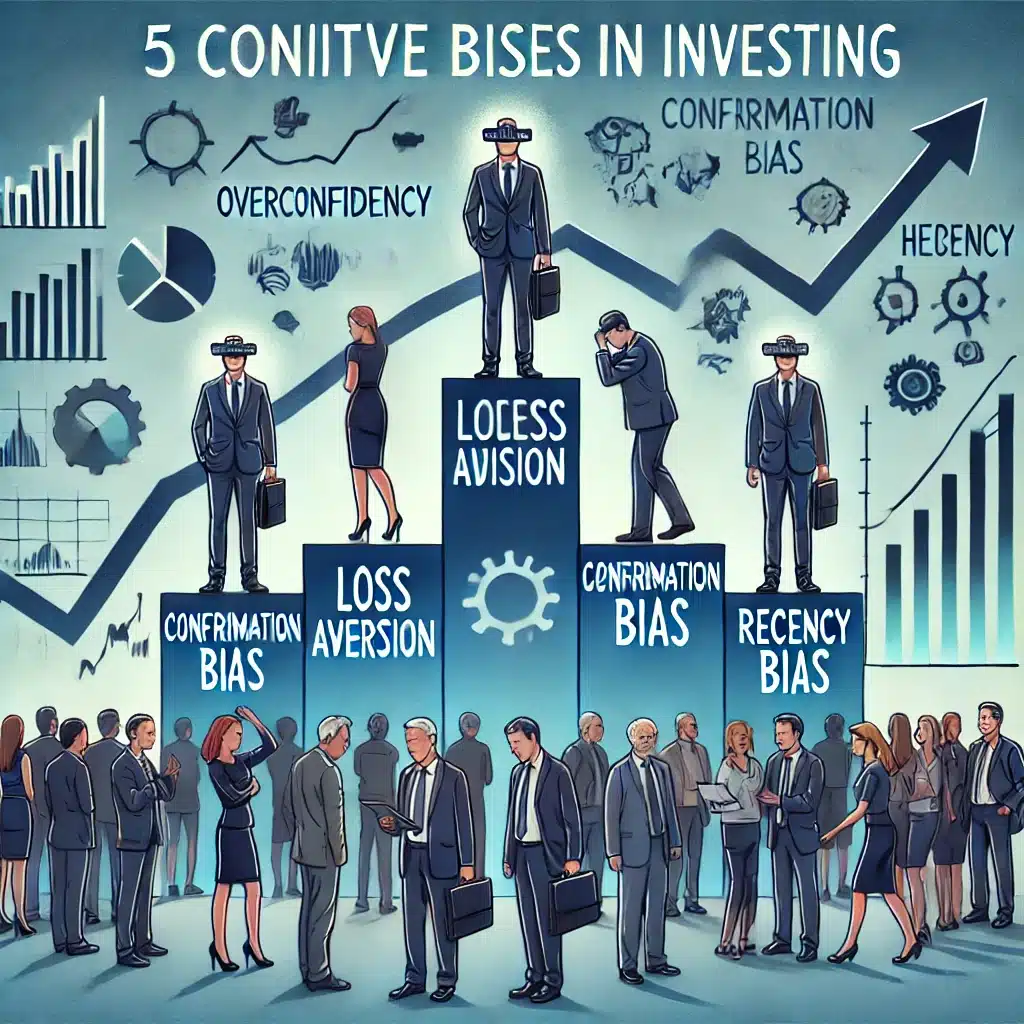
Approx. read time: 7.5 min.
Post: Hard Earned Truth: These Are the Five Cognitive Biases That You Should Fear Most
Investing, by its very nature, is fraught with uncertainty. It involves making decisions today based on what may happen tomorrow, all while balancing risk and reward. In an ideal world, we would approach each investment decision with clarity and logic, always choosing the most rational option that maximizes our returns. But the real world isn’t like that. Cognitive biases — those subtle, often subconscious psychological tendencies — constantly trick our brains into making irrational decisions, especially when it comes to money.
How Cognitive Biases Affect Investing
The stock market provides an excellent example of how these biases can undermine decision-making. Imagine if, at the end of 2019, investment experts had warned you about a looming global pandemic that would send markets into a tailspin. Would you have held onto your global equities? Likely not. It’s not the market volatility or crashes that matter, but rather how you respond to them. Managing your cognitive biases could mean the difference between selling in a panic and holding steady to reap long-term rewards.
While there are over 200 documented cognitive biases, five of them stand out as particularly dangerous for investors. These five can wreak havoc on your portfolio if you don’t learn how to tame them. Here’s how each one works — and how to avoid falling into their traps.
1. Overconfidence Bias
Overconfidence is perhaps the most common and pernicious cognitive bias in investing. It occurs when investors believe they have superior knowledge or control over a situation, leading them to underestimate risks and make poor decisions. As legendary mutual fund manager Sir John Templeton once said, “The four most dangerous words in investing are, ‘it’s different this time.’” Investors who fall into the trap of overconfidence tend to believe they have a special insight into the market that others don’t.
How Overconfidence Bias Hurts Investors
For example, after a few successful trades, an investor might start to feel invincible. They might believe they can predict short-term market trends and decide to go all-in on a particular stock or sector, convinced of their unique insight. However, this often leads to impulsive behavior, including market timing, concentrated portfolios in risky assets, and overtrading — all of which can significantly increase transaction costs and risks.
Overconfidence is dangerous because it closes you off from alternate perspectives. A hallmark of a good investor is humility and the willingness to consider other points of view. To avoid the trap of overconfidence, it’s essential to continuously seek advice from diverse sources, question your assumptions, and recognize that no one can consistently predict the market.
2. Loss Aversion
Loss aversion, a principle brought to light by behavioral economists Daniel Kahneman and Amos Tversky in the 1970s, refers to the idea that the pain of losing is about twice as strong as the pleasure of gaining. In practical terms, a 10% loss feels much worse than the satisfaction of a 10% gain. This natural aversion to loss can drive us to make irrational decisions.
Loss Aversion in Action
For example, suppose an investor buys a stock that immediately suffers a significant loss. Instead of cutting their losses and moving on, they may hold onto the stock, hoping for a miraculous rebound — even if all indicators suggest that the stock’s future prospects are bleak. This behavior, known as the “disposition effect,” arises because people dislike the idea of locking in a loss. They’d rather hold onto a poor investment in the hopes that it will recover than face the pain of admitting they made a bad decision.
But loss aversion doesn’t just apply to individual stocks. It can also cause investors to become overly cautious, avoiding risk altogether. While being cautious has its benefits, being too risk-averse can mean missing out on potentially profitable opportunities. The key to overcoming loss aversion is to focus on the long-term picture and accept that short-term losses are often a necessary part of investing. Diversification, staying informed, and sticking to a well-thought-out investment plan are all essential strategies to mitigate the effects of loss aversion.
3. Confirmation Bias
Confirmation bias is the tendency to seek out information that confirms your pre-existing beliefs while ignoring or discounting information that contradicts them. In investing, this bias can be especially harmful because it leads to skewed decision-making. Investors might latch onto news or data that supports their investment decisions while conveniently ignoring red flags.
How Confirmation Bias Skews Investment Decisions
For example, an investor might have a strong belief in the future of a particular tech stock. They will gravitate towards news articles, analysts’ opinions, or social media posts that reinforce their positive view of the stock while ignoring or dismissing any negative analysis or warnings. This one-sided approach can prevent investors from seeing the full picture and making rational decisions.
Confirmation bias is problematic because it narrows your perspective and leaves you vulnerable to unexpected market changes. To combat this, it’s crucial to actively seek out opposing viewpoints. If you’re bullish on a particular stock or sector, try to find credible sources that challenge your position. By doing so, you’ll gain a more balanced understanding of the risks and opportunities.
4. Herding
Herding occurs when people follow the actions of a larger group, often without independent analysis. It’s human nature to assume that if many others are making a particular decision, it must be the right one. In the world of investing, herding behavior is especially prevalent during times of uncertainty, and it can lead to market bubbles and crashes.
Examples of Herding Behavior
A prime example of herding behavior is the dot-com bubble of the late 1990s or the housing bubble of the mid-2000s. In both cases, investors, driven by the fear of missing out (FOMO), jumped on the bandwagon, buying up tech stocks or real estate simply because everyone else was doing it. The result? Skyrocketing asset prices followed by devastating crashes.
Herding can cause investors to buy high and sell low — the exact opposite of what they should be doing. It’s tempting to follow the crowd, especially in the age of social media where investment trends can spread like wildfire. However, just because everyone else is doing something doesn’t mean it’s the best move for you. To avoid herding, it’s essential to have a clear investment strategy based on your own financial goals and risk tolerance. Stick to your plan, even when everyone around you seems to be making different decisions.
5. Recency Bias
Recency bias refers to the tendency to give more weight to recent events or experiences when making decisions, often at the expense of considering long-term trends or historical data. Investors experiencing recency bias might assume that because the market has been performing well recently, it will continue to do so indefinitely. Conversely, after a market downturn, they might become overly cautious, believing that the decline will persist.
The Dangers of Recency Bias in Investing
Recency bias was on full display during the bull market in tech stocks, bitcoin, and meme stocks like GameStop. Many investors, buoyed by recent gains, believed these stocks would continue to rise and piled into them without considering the risks. When markets eventually corrected, those who had succumbed to recency bias faced significant losses.
This bias can be particularly dangerous during times of transition, such as approaching retirement when market volatility may seem especially frightening. To combat recency bias, it’s essential to take a long-term view and base decisions on a comprehensive analysis of historical data, not just recent trends. Maintaining a diversified portfolio that can weather short-term fluctuations is also key to overcoming recency bias.
Conclusion: Taming Your Biases for Better Investment Outcomes
To be a successful investor, it’s not enough to understand financial markets, read balance sheets, or follow stock trends. You also need to understand your own mind and the psychological traps that can lead you astray. Cognitive biases are powerful forces, but they’re not insurmountable. By recognizing and mitigating the effects of overconfidence, loss aversion, confirmation bias, herding, and recency bias, you can make more rational, thoughtful investment decisions.
The bottom line is that investing requires discipline, a well-thought-out strategy, and the ability to stick to that strategy, even in the face of market volatility and uncertainty. Diversify your portfolio, focus on your long-term goals, and avoid the temptation to tinker too much based on short-term market movements. The less you let cognitive biases influence your decisions, the more successful you’ll be in growing your wealth over time.
Related Videos:
Related Posts:
The Role of Social Media Algorithms in Reinforcing User Biases and the Impending AI Challenge
Automotive Company Magna Invests in Artificial Intelligence
Addressing the Biases Plaguing AI Algorithms
Magna International Inc. Stock Tumbles: An Analysis of Tuesday’s Market Performance
Impending Surge: How China’s Regulatory Shift Could Reshape Bitcoin, Ethereum, and XRP Markets









